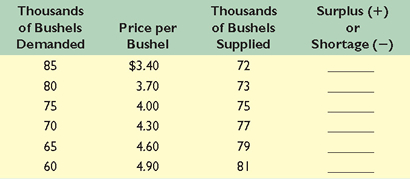Economics (McConnell), 18th EditionChapter 3:
Demand, Supply and Market Equilibrium (+ Appendix)Key Questions1. What effect will each of the following have on the demand for small automobiles such as the Mini Cooper and Smart car? - Small automobiles become more fashionable.
- The price of large automobiles rises (with the price of small autos remaining the same).
- Income declines and small autos are an inferior good.
- Consumers anticipate that the price of small autos will greatly come down in the near future.
- The price of gasoline substantially drops.
2. What effect will each of the following have on the supply of auto tires? - A technological advance in the methods of producing tires.
- A decline in the number of firms in the tire industry.
- An increase in the prices of rubber used in the production of tires.
- The expectation that the equilibrium price of auto tires will be lower in the future than currently.
- A decline in the price of the large tires used for semi trucks and earth-hauling rigs (with no change in the price of auto tires).
- The levying of a per-unit tax on each auto tire sold.
- The granting of a 50-cent-per-unit subsidy for each auto tire produced.
3. Suppose the total demand for wheat and the total supply of wheat per month in the Kansas City grain market are as shown in the accompanying table. - What is the equilibrium price? What is the equilibrium quantity? Fill in the surplus-shortage column and use it to explain why your answers are correct.
- Graph the demand for wheat and the supply of wheat. Be sure to label the axes of your graph correctly. Label equilibrium price P and equilibrium quantity Q.
 <a onClick="window.open('/olcweb/cgi/pluginpop.cgi?it=jpg::::/sites/dl/free/0025694212/668710/KeyQuestion_Ch03_Graph01.jpg','popWin', 'width=NaN,height=NaN,resizable,scrollbars');" href="#"><img valign="absmiddle" height="16" width="16" border="0" src="/olcweb/styles/shared/linkicons/image.gif"> (44.0K)</a> <a onClick="window.open('/olcweb/cgi/pluginpop.cgi?it=jpg::::/sites/dl/free/0025694212/668710/KeyQuestion_Ch03_Graph01.jpg','popWin', 'width=NaN,height=NaN,resizable,scrollbars');" href="#"><img valign="absmiddle" height="16" width="16" border="0" src="/olcweb/styles/shared/linkicons/image.gif"> (44.0K)</a> - Why will $3.40 not be the equilibrium price in this market? Why not $4.90? "Surpluses drive prices up; shortages drive them down." Do you agree?
4. How will each of the following changes in demand and/or supply affect equilibrium price and equilibrium quantity in a competitive market; that is, do price and quantity rise, fall, or remain unchanged, or are the answers indeterminate because they depend on the magnitudes of the shifts? Use supply and demand diagrams to verify your answers. - Supply decreases and demand is constant.
- Demand decreases and supply is constant.
- Supply increases and demand is constant.
- Demand increases and supply increases.
- Demand increases and supply is constant.
- Supply increases and demand decreases.
- Demand increases and supply decreases.
- Demand decreases and supply decreases.
5. Refer to the table in question 8. Suppose that the government establishes a price ceiling of $3.70 for wheat. What might prompt the government to establish this price ceiling? Explain carefully the main effects. Demonstrate your answer graphically. Next, suppose that the government establishes a price floor of $4.60 for wheat. What will be the main effects of this price floor? Demonstrate your answer graphically.  Chapter 03 Key Question Solutions
(438.0K) Chapter 03 Key Question Solutions
(438.0K)
 | 

















